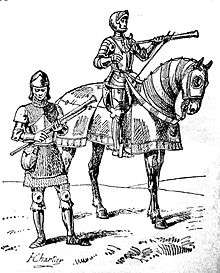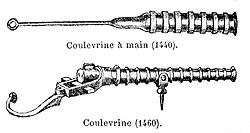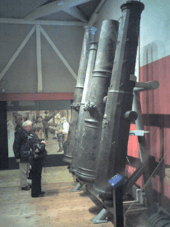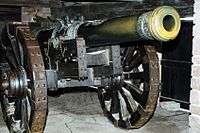Culverin
A culverin was a relatively simple ancestor of the musket, and later a medieval cannon, adapted for use by the French as the "couleuvrine" (from couleuvre "grass snake") in the 15th century, and later adapted for naval use by the English in the late 16th century. The culverin was used to bombard targets from a distance. The weapon had a relatively long barrel and a light construction. The culverin fired solid round shot projectiles with a high muzzle velocity, producing a relatively long range and flat trajectory. Round shot refers to the classic solid spherical cannonball.

Hand culverins
The term culverin is derived from the Latin, colubrinus, or "of the nature of a snake". It was originally the name of a medieval ancestor of the musket, used in the 15th and 16th centuries.[1]
The hand culverin consisted of a simple smoothbore tube, closed at one end except for a small hole designed to allow ignition of the gunpowder. The tube was held in place by a wooden piece which could be held under the arm. The tube was loaded with gunpowder and lead bullets. The culverin was fired by inserting a burning slow match into the hole.
These hand culverins soon evolved into heavier portable culverins, around 40 kg (88 lb) in weight, which required a swivel for support and aiming. Such culverins were further equipped with back-loading sabots to facilitate reloading, and were often used on ships. Many were immobile due to their heavy weight.
 "Hand bombard", or early culverin, 1390–1400
"Hand bombard", or early culverin, 1390–1400 Hand culverin (middle) with two small cannons, Europe, 15th century
Hand culverin (middle) with two small cannons, Europe, 15th century Early culverins (15th century): a hand culverin (top), and a sabot-loaded culverin (bottom)
Early culverins (15th century): a hand culverin (top), and a sabot-loaded culverin (bottom) "Murderer", 1410 France
"Murderer", 1410 France
Field culverins

There were three types of culverin in use, distinguished by their size: the "culverin extraordinary", the "ordinary", and the "least-sized".[2]
| Name | Bore diameter | Length | Weight | Shot diameter | Shot weight |
|---|---|---|---|---|---|
| Culverin extraordinary | 5 1⁄2 in (140 mm) | 32 calibers (14 ft 8 in; 4.47 m) | 4,800 lb (2,200 kg) | 5 1⁄4 in (130 mm) | 20 lb (9.1 kg) |
| Ordinary culverin | 5 1⁄2 in (140 mm) | 25 calibers (12 ft; 3.7 m) | 4,500 lb (2,000 kg) | 5 in (130 mm) | 17 lb 5 oz (7.9 kg) |
| Culverin of the least size | 5 in (130 mm) | 29 calibers (12 ft; 3.7 m) | 4,000 lb (1,800 kg) | 3 1⁄4 in (83 mm) | 14 lb 9 oz (6.6 kg) |
There were also smaller versions, including the "bastard culverin" (4 inches; 100 mm), 7-pound (3.2 kg) shot and the "demi-culverin" or "culverin-moyen" (4 1⁄2 inches; 110 mm), 10-pound (4.5 kg) shot.[1]
Overall, the culverin was a significant advance. Since it fired a ball of iron and relied on gunpowder for propulsion, the heavy ball meant a relatively stable flight and the gunpowder propulsion meant a fast and long-range. A replica culverin extraordinary has achieved a muzzle velocity of 408 m/s, and a range over 450 metres (1,480 ft) using only minimal elevation.[3] This velocity and mass imply that the cannonball had a kinetic energy of roughly 600 kilojoules (440,000 ft⋅lbf) when leaving the muzzle.
The culverin was later replaced by the field gun once technology had advanced to the point where cannonballs had become explosive.
See also
References
- "culverin". Oxford English Dictionary (3rd ed.). Oxford University Press. September 2005. (Subscription or UK public library membership required.)
-

- Discovery Channel, Battlefield Detectives, episode "Who Sank the Armada"
External links
| Wikimedia Commons has media related to Culverins. |
